Shiprock, known as Tsé Bitʼaʼí in Navajo, meaning “rock with wings,” is one of the most awe-inspiring geological features in the American Southwest. Rising nearly 1,583 feet (482.5 meters) above the desert plain in northwestern New Mexico, Shiprock is a monadnock — a peak that stands alone above the surrounding terrain — and plays an essential role not only in the region’s geological landscape but also in the traditions, spirituality, and mythology of the Navajo people. Revered as sacred, Shiprock embodies a deep connection between land, myth, and the enduring spirit of the Navajo. In this article, we will delve into the history, geology, and cultural significance of Shiprock, exploring the ancient myths that shape its identity and the modern-day fascination with this majestic rock formation.
The Origins of Shiprock: Geological Formation and Features
Shiprock is a volcanic plug, an exposed neck of a once-active volcano, created more than 30 million years ago. The rock was once the throat of a volcano, where molten rock from the Earth’s mantle rose to the surface, interacting explosively with water and forming a diatreme—a carrot-shaped volcanic vent. Over time, erosion stripped away the softer surrounding rock layers, leaving behind the more resistant volcanic material, which we recognize today as Shiprock.
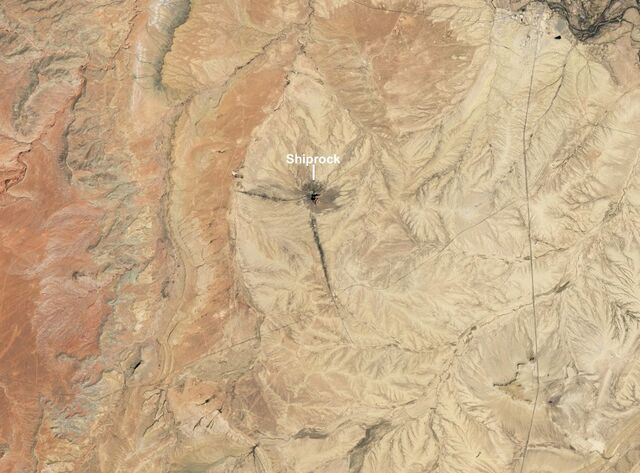
The structure itself rises 1,583 feet above the surrounding desert, with a total elevation of 7,177 feet (2,188 meters) above sea level. It stands as a solitary sentinel in the arid landscape, offering one of the most recognizable geological formations in the American Southwest. Shiprock’s towering presence, with its jagged cliffs and surrounding rock dikes that radiate out in various directions, marks it as a geological marvel. Its volcanic origins and subsequent erosion have made Shiprock one of the best-known diatremes in the United States.
Video
Watch The Ancient Volcano in New Mexico; Shiprock to explore the fascinating history of this volcanic formation. Don’t miss it!
Shiprock in Navajo Mythology: Sacred Land and Spiritual Connection
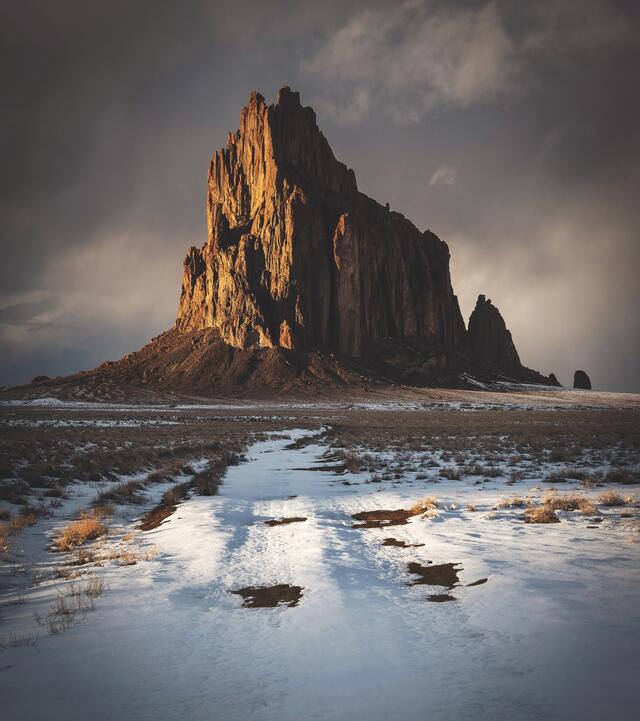
Shiprock is not just a geological wonder—it holds profound spiritual significance for the Navajo people. Known as Tsé Bitʼaʼí, or “rock with wings,” the formation is linked to a powerful myth about the origins of the Navajo people. According to Navajo legend, the great bird carried the Navajo ancestors from the cold northlands to the Four Corners region of the American Southwest. As the bird flew across the sky for a day and night, it carried the Navajo people on its back. When the bird finally landed, it became Shiprock.
The legend continues with the story of the Navajo people’s time on the rock. After the bird landed and the people disembarked, they lived on Shiprock, descending only to tend their fields and gather water. However, a battle with a creature known as Cliff Monster changed everything. This monster built a nest on the back of the bird, trapping it on the rock. A brave hero, Monster Slayer, was sent to defeat the monster. After an epic struggle, Monster Slayer decapitated Cliff Monster, and in the process, the great bird, the embodiment of the Navajo ancestors’ protection and guidance, was fatally wounded. To preserve the bird and honor its sacrifice, Monster Slayer turned the bird to stone, creating the Shiprock formation we see today.
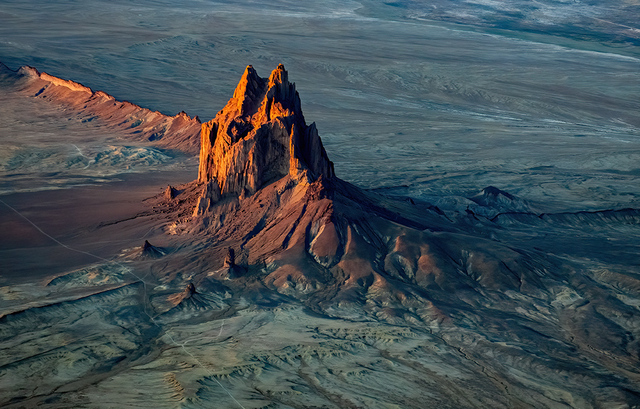
For the Navajo, Shiprock is not just a physical landmark, but a living testament to their ancestral myths and spiritual beliefs. Its prominent role in ceremonies, particularly those involving healing and protection, reflects the deep reverence with which it is viewed. Many Navajo ceremonies, including the Enemy Side Ceremony and the Navajo Mountain Chant, feature references to Shiprock, highlighting its importance as a source of strength and guidance.
Shiprock’s Name: From The Needle to Ship Rock
Shiprock’s name has evolved over time. Initially, the peak was known as “The Needle” when Captain J. F. McComb, an early explorer, named it in 1860 due to its pointed pinnacle. However, as time went on, its name was changed to “Shiprock,” based on its resemblance to a 19th-century clipper ship. The shape of the formation, with its towering spires and sharp, prominent features, reminded early settlers of the grand sailing ships of the era. This name has stuck ever since, and today it is not only used to describe the rock formation but also the nearby town of Shiprock, New Mexico.
Climbing Shiprock: A Forbidden Challenge
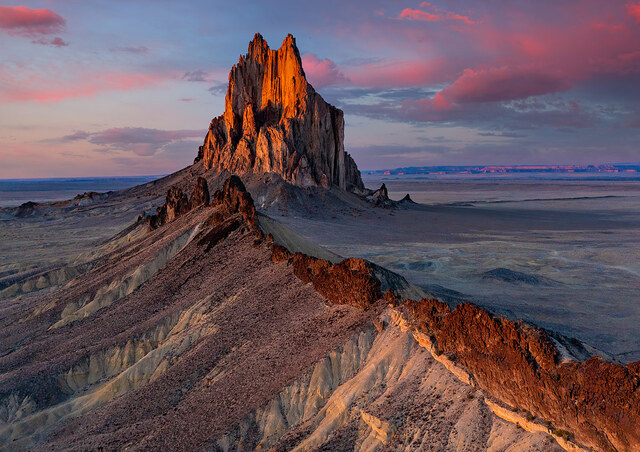
Shiprock has long been a point of interest for adventurers and rock climbers, drawn by its striking appearance and the challenge it presents. The first successful ascent of Shiprock occurred in 1939, when a group of climbers led by David Brower made their way to the top of the peak. The climb was difficult and dangerous, involving intricate maneuvers with ropes and pitons. The team even used expansion bolts—an innovation in American climbing at the time—to help secure their ascent.
However, despite its allure to climbers, Shiprock is illegal to climb today. In 1970, a tragic accident that resulted in the death of a climber led the Navajo Nation to declare a permanent ban on climbing the formation. The ban, enforced by the Navajo government, was implemented out of respect for Shiprock’s sacred status in Navajo tradition, as well as the belief that climbing the peak would disturb the spirits of the ancestors. The presence of ghosts, or chį́įdii (spirits), is said to haunt the site, and climbing it would risk stirring these spirits, causing misfortune.
While the ban remains in place, some climbers have still managed to scale Shiprock, though these attempts are rare and controversial. The sacred nature of the site and the Navajo prohibition against climbing have made Shiprock a topic of intense debate among climbers, anthropologists, and Navajo cultural advocates alike.

Shiprock’s Unique Geology: Volcanic Dikes and Rock Formations
Geologically, Shiprock is unique for its volcanic dikes—long, vertical rock walls formed when magma filled cracks in the Earth’s crust during volcanic activity. These dikes radiate out from the central peak in multiple directions, creating a distinctive feature of the landscape. The dikes are formed from basalt, a type of volcanic rock, and are a result of the lava interacting with the surrounding sedimentary rocks as the volcano erupted.
In addition to the dikes, the main formation itself is composed of various volcanic rocks, including tuff-breccia, a combination of welded rock fragments. The exposure of these volcanic rocks, combined with the surrounding erosion-resistant nature of the rock, makes Shiprock an easily recognizable and striking feature in the landscape. Over time, erosion has removed much of the surrounding bedrock, further highlighting the prominent rock structure.
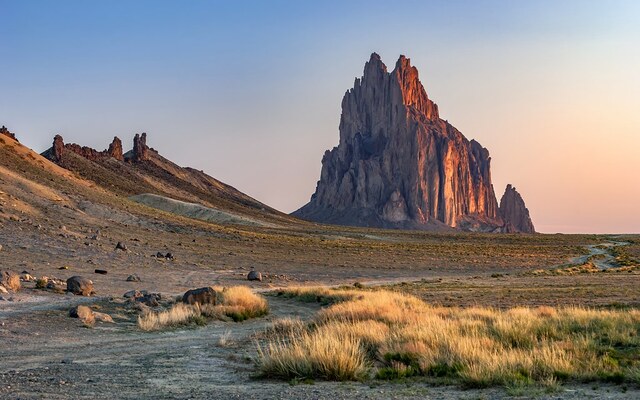
The Importance of Shiprock Today
Today, Shiprock continues to be an important symbol of the Navajo people and their culture. It is not only a geological marvel but a reminder of their ancestors’ journey, their struggles, and their victories. For the Navajo, Shiprock represents strength, endurance, and the interconnectedness of land, spirit, and history.
While the formation is now protected by the Navajo Nation, it remains a site of pilgrimage for many Navajo people and a subject of interest for those who seek to understand the deeper connection between the natural world and the cultural history of the Southwest. Whether one views it as a sacred mountain or a geological wonder, Shiprock stands as a monumental testament to the enduring power of nature and myth, reminding us all of the deep connections that link the past with the present.
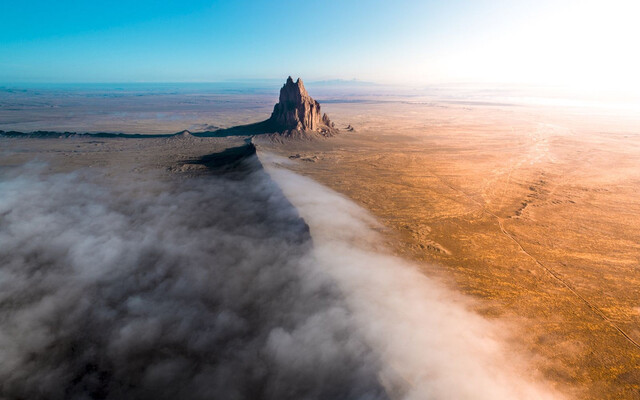
Conclusion: Shiprock as a Symbol of Culture and Nature
Shiprock, with its towering spires and sacred status, is a symbol of both the natural world and the rich cultural history of the Navajo people. From its geological formation as a volcanic plug to its place in Navajo mythology as a bird that brought the people to their homeland, Shiprock is more than just a mountain. It is a living, breathing part of the Navajo identity, a reminder of their ancestral roots and spiritual connections. Today, Shiprock remains an awe-inspiring site that draws visitors from around the world, offering a glimpse into the ancient world while respecting the cultural beliefs of those who have called it home for centuries.
Video
Watch Shiprock, New Mexico: The Aerial Experience to see this stunning volcanic formation from above. Don’t miss the breathtaking views!



